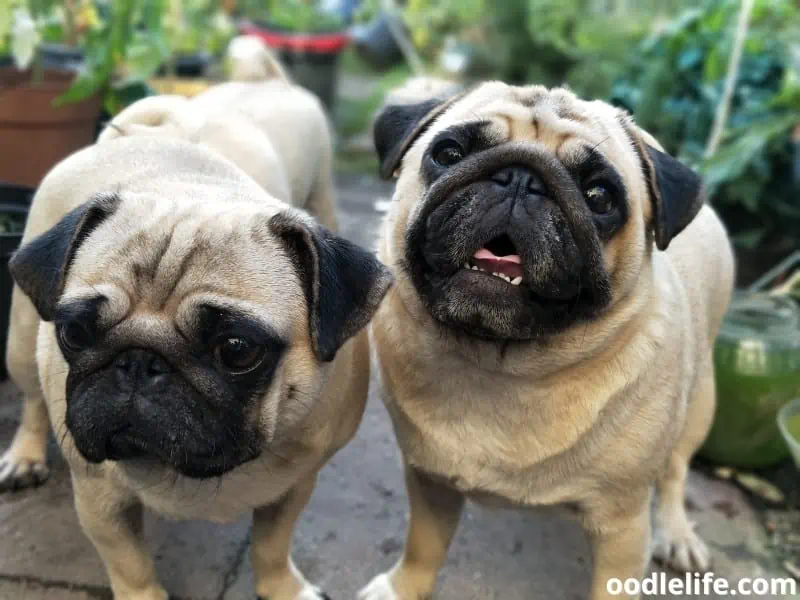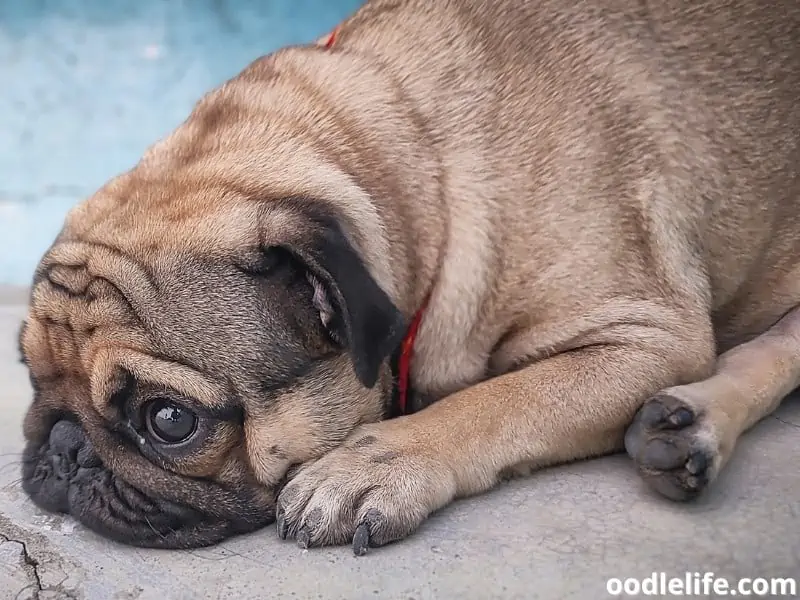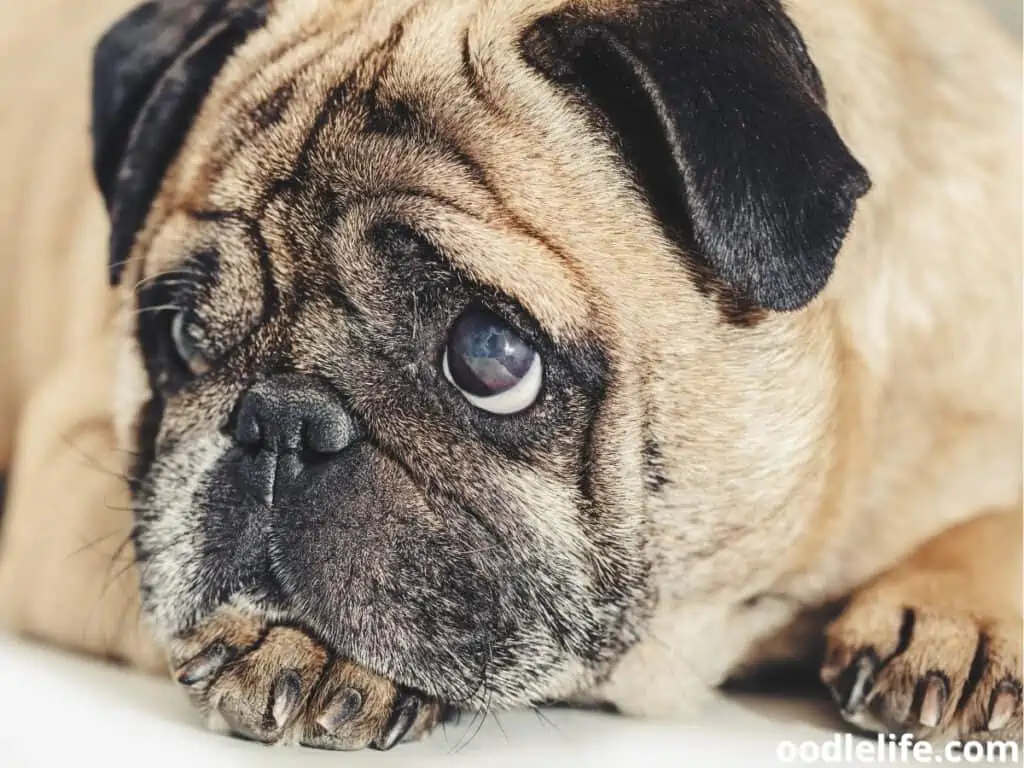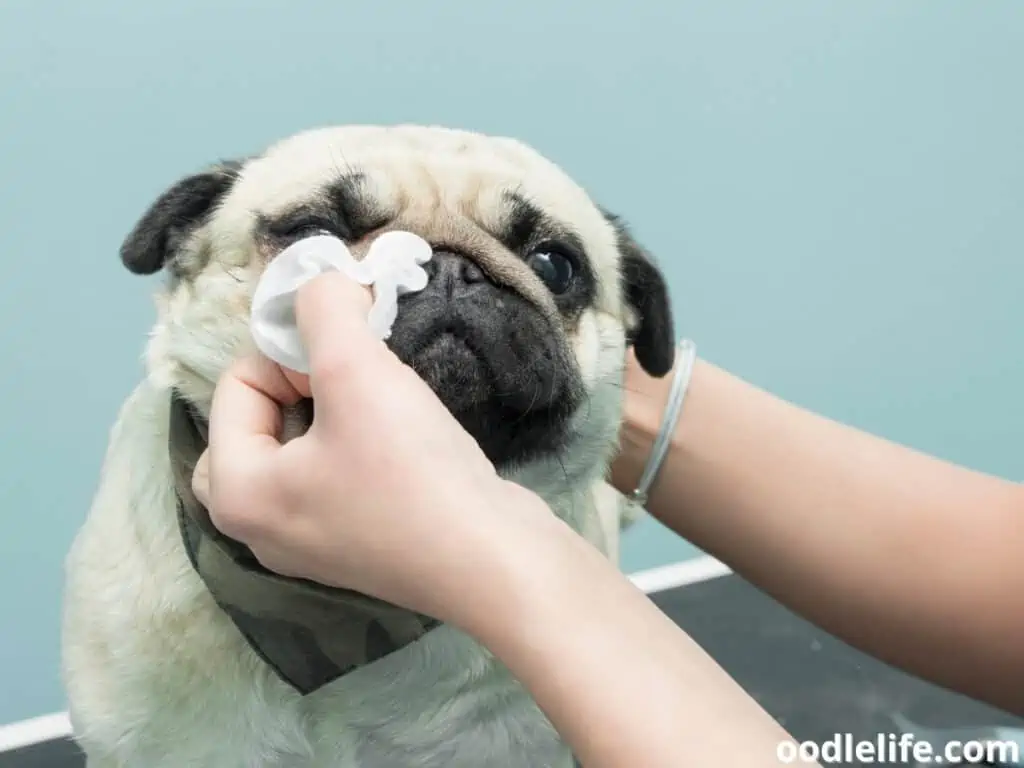How Big Does a Pug Get? (Table)
A common concern among new Pug parents is, “How big does a Pug get?”
Your Pug attains 80% of its body weight and up to 90% of its height during the first year. If your Pug continues adding weight past 18 pounds, that could be a sign of obesity.

Full-grown Pugs weigh 13 to 18 pounds (5.89 to 8.16 kg), and their height is 10 to 13 inches. They live for 13-15 years. Mature males and females don’t vary in weight as other dog breeds.
By the time a Pug is six months old, they’re sexually mature and weigh 7-12 pounds. At nine months, most Pugs are fully grown but will continue adding weight until they reach one year.
Pug Weight and Growth Chart
Pugs are a small dog breed. Some may be fatter while others may be taller, but if they’re purebred, they’re almost always the same size.

Even gender doesn’t impact Pugs’ overall size much like in other dog breeds. Male and female Pugs grow at the same rate and are roughly the same in adulthood.
Like most small dog breeds, Pugs are fully grown at nine months and will continue to add a bit of muscle until they’re one year old. Their growth is faster than medium to large dogs.
Six-month-old Pugs weigh an average of 7 – 12 pounds and are already sexually mature. They’re close to their full adult height, 10 to 13 inches, at this age. To get a Pug’s height, measure from the footpad to the top of their shoulders when standing.
A look at your Pug’s paws will tell you if they are still growing. If their paws look big, that’s a sign they’ll keep growing.
The table below represents Pug’s age and weight from one month to a year:
| Age | Weight |
| 1 month | 1 – 2 lbs. |
| 2 months | 5 – 9 lbs. |
| 3 months | 7 – 10 lbs. |
| 4 months | 7 – 12 lbs. |
| 5 months | 9 – 12 lbs. |
| 6 months | 7 – 12 lbs. |
| 7 months | 9 – 12 lbs. |
| 8 months | 11 – 14 lbs. |
| 9 months | 14 – 18 lbs. |
| 10 months | 14 – 18 lbs. |
| 11 months | 14 – 18 lbs. |
| 12 months | 14 – 18 lbs. |
How Big Is a Full-Grown Pug?
So, how big does a Pug get? A full-grown Pug weighs between 14 and 18 pounds and stands 10 to 13 inches tall. A full-grown Pug is usually compact and not lean.

If your Pug continues adding weight past 18 pounds, consult a veterinarian. According to the Veterinary Centers of America, canine obesity affects 25 – 30 % of the general canine population.
To estimate your Pug’s weight in adulthood, divide the Pug’s weight in pounds by its age in weeks. Then multiply what you get by 52 (weeks in a year). The results are estimates but will show you how big your Pug will grow.
Another method is to take your Pug’s weight at six weeks, double it, and double it again to get the ideal weight.
The table below summarizes a full-grown Pug’s weight, length, standing height, withers height, and lifespan.
| Weight | 14 -18 lbs. (6.4-8.2 kg) |
| Length | 15.5”-20.5” (39-52 cm) |
| Withers height | 10”-13” (25-33 cm) |
| Standing height | 13” 17” (33-43 cm) |
| Lifespan | 13-15 years |
What To Expect From Birth to Adult?
Expect the following changes as your Pug grows.

Birth – 2 Weeks
Pugs are tiny, meaning they won’t weigh much at birth. Their body weight should double during the first week. They should gain about 5% daily weight.
Pugs grow fast at the beginning, even though they’re still deaf, blind, and toothless.
3 Weeks – 12 Weeks
Pug puppies interact with their environment at three weeks. Their bladder control is developing, and they can leave their bed to poop or pee elsewhere.
They weigh 2-4 pounds at eight weeks and can start potty training. At nine weeks, they can learn commands. Your Pug should weigh at least six pounds at 12 weeks.
3 Months – 4 Months
Your Pug should now weigh 5-8 pounds. They’ve also started teething and will chew on almost anything. Provide safe chewable toys for your puppy so they won’t destroy household items.
4 Months – 6 Months
At this stage, Pugs weigh 7 – 12 pounds. If they’re bigger without being overweight, there’s no need to worry.
6 Months – 9 Months
When your Pug reaches nine months, they’re almost at adulthood size. Still, they’ll continue adding weight even after nine months and should weigh about 19 pounds. Your Pug should also be through with teething.
1 Year
Your Pug is now an adult, even when they display puppy tendencies. During the first year, your Pug attains 90% of its height and 80% of its weight.
1 Year – 18 Months
Once Pugs attain one year, they’ve already achieved full height. The adult Pug then begins to fill out widthwise, especially in the chest, which becomes muscular. Any additional weight at this age is unhealthy for your Pug.
1.5 Years – 7 Years
Your dog is now full grown, and the size is set. The Pug can now be considered as being in its prime years.
8 Years and Beyond
There’s no exact age to define a senior dog, but old Pugs fall under this age bracket. Nine years is when most Pugs are categorized as seniors.
How To Stop Your Pug From Gaining Excess Weight?
How big does a Pug get? Pugs can grow big until they become overweight, especially since they love eating and sleeping.

Sometimes, Pugs resist going for walks or doing other exercises. Their begging skills are also good and can make you overfeed them each time they beg for food.
Consider implementing the following tips to prevent your Pug from growing too big:
- Stick to the feeding portions recommended by the manufacturer or vet.
- Minimize treats between meals or replace them with less fattening ones.
- Schedule regular vet visits so your Pug’s weight is kept under control.
- Schedule regular walks even when your Pug initially refuses to participate.
What Health Problems Affect Growth of Pugs?
The following health complications might hinder your Pug’s growth.
Encephalitis
Pugs are affected by Dog Encephalitis, a neurological disease that occurs in adolescence. The disease is characterized by inflammation of the brain.

Pug Dog Encephalitis (PDE) is idiopathic (the cause is unknown), but it’s thought to be hereditary.
The disease symptoms include banging the head against surfaces, losing coordination, and walking around in circles.
Allergies
Dog allergies cause itching rather than sneezing. Itching allergies are called atopy and are common in Pugs. Their bellies, feet, ears, and skin folds are the most affected.

Symptoms start between one and three years and can continue to worsen over time. The symptoms include rubbing the face, licking paws, and recurrent ear infections.
Keratitis
Pugs’ large prominent eyes predispose them to Pigmentary Keratitis, which can partially block vision. It affects the cornea (the clear part of the eye). Pigment builds up in the cornea and results in dark-looking eyes.

Pugs with Pigmentary Keratitis are likely to trip and fall, or they may hesitate to walk because they’re afraid of falling.
Bones and Joints Issues
Hips and elbows risk dysplasia, which causes improper joint development and can cause arthritis.

Take your Pug for examination when they start showing lameness in the legs or difficulty when rising from a lying position.
Taking Care of Your Pug
A Pug’s eyes are the most sensitive part. Their flat faces and noses expose their eyes to injuries or infections, so you shouldn’t let your dog play with objects that could scratch their eyes.

Their flat faces also cause Brachycephalic Syndrome, which blocks a Pug’s air pathway. The Pug becomes unable to breathe through the nose and can suffer from respiratory distress. Pugs also snore a lot due to this condition.
Pugs don’t do well in hot weather and can suffer heat stroke because of their short muzzle. Protect your Pug by keeping them indoors whenever the weather is hot.
Pugs are also prone to health problems like cancer and knee dislocations. Skin irritation may also occur due to the folds on their skin. Therefore, the skin under the folds should be cleaned and dried carefully.
Pug coats are short and glossy, which makes them look like they can’t shed fur, but they shed heavily and need regular brushing.
Since Pugs are prone to obesity due to overeating and inactivity, you’ll have to take charge of their health and feed them healthy food while encouraging them to exercise.
Bathe your Pug and trim their nails as needed. I trim my Pug’s nails every few weeks, and because Pugs are prone to dental issues, I clean her teeth twice a week. Take your Pug for professional cleaning once a year.
When your Pug becomes a senior, invest in an orthopedic canine bed. Your dog will find relief, especially if they have arthritis.
So, How Big Does a Pug Get?
Pugs stand between 10 and 13 inches tall and weigh between 13 and 18 pounds (5.89 to 8.16 kg) at maturity. They have a 13–15 year lifespan. Unlike other dog breeds, mature males and females do not weigh differently.
Pugs reach sexual maturity at six months and weigh 7 to 12 pounds. Most Pugs are fully developed by the time they are nine months old, although they still gain weight up until they are a year old.